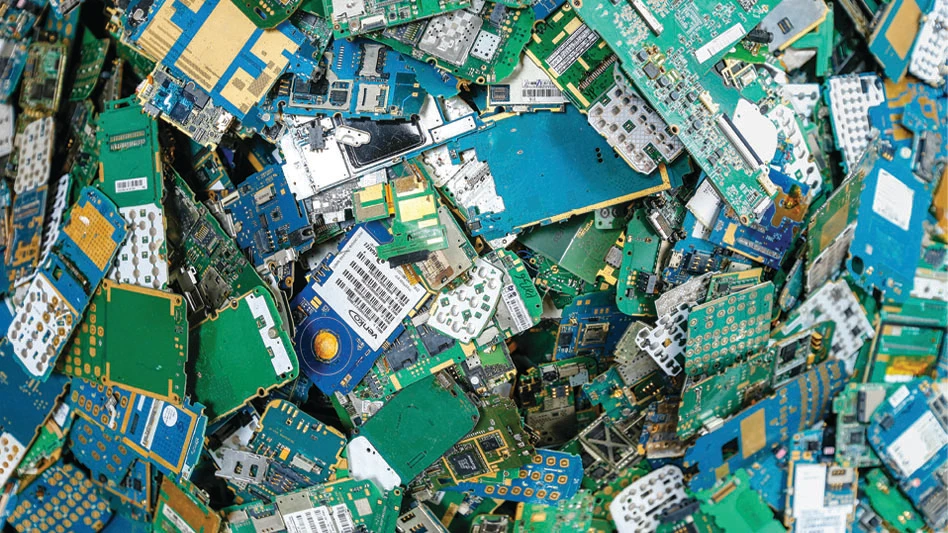Although C&D recycling is active in the East Coast and Great Lakes regions, turning a profit is still a challenge for many processors.
There may be some truth to the notion that a contractor can afford to tear down a building just to get the demolition materials for recycling. However, those in the business know that marketing construction and demolition debris at a profit is more complicated than that.
Three factors affect the profitability of C&D recycling: first, markets for profitable recycling of C&D debris are driven mainly by legislation or regulation; second, while increased tipping fees in most areas of the country will make recycling more attractive, the opposite also is true; third, the increasing cost of trucking material from the site to a plant keeps inching upward, nibbling into profits.
Along the East Coast and across the Great Lakes, the C&D recycling business is currently quite active, though not always profitable.
Prices are as good today for many components as they’ve been in years. Scrap steel plating and structural material is going for $130 a ton, the strongest it has been in a decade. With copper at $1 a pound, there’s a lot of money to be made there.
A lot of transfer stations and landfills have dropped their prices to compete with recycling operations, notes Jeff Thornton, business and planning manager at Delaware Valley Recycling, Inc., Philadelphia. "A lot of them would rather not see material recycled," he says, "so they’ve brought their numbers down. It’s not a giant spread — it’s close and it depends on what you are recycling."
Generally, landfills in the Philadelphia area are averaging in the mid-to-low $40 range per ton of C&D material dumped, putting them even with, or even $2 cheaper than, recycling operations. Despite much ballyhoo, the shortage of landfill space reported in the Northeast does not seem to be having much effect on the landfills yet.
MORE MARKETS
Just as municipal recyclers had to take the time to foster markets for recycled materials collected at curbside, C&D recyclers are finding the need to increase the acceptance of C&D debris for applications such as highways.
"We would like more markets," says Michael Taylor, executive director of the National Association of Demolition Contractors, Doylestown, Pa. "It would be nice if the government would allow specifications calling for just one-half percent recycled C&D waste on state highway projects."
In aggregate-poor states, like Florida, C&D debris is valued. But in aggregate-rich states, like Pennsylvania, the quarry interests feel there is enough competition among themselves that they don’t want to see any other parties fighting for their share of the market. Their powerful lobbyists are afraid to let recycling get a foot in the door, even at as low a rate as one-half percent.
"There is a good market for aggregate at $5 to $12 per ton in most markets," notes David Hawker, president of Hazemag USA, Uniontown, Pa. But there’s little incentive to haul demolition debris far for that kind of money.
"There is another element," Hawker points out. "That’s the cost of processing — that is, the fixed cost of the plant. You’d be nuts to invest several million in a plant if you don’t have other factors in mind.
"Politics is fickle," he continues. "Regulations change, there can be a doubling of tipping fees in a short while, a change in classification of a material to hazardous. Historically, contractors have been good at tearing down buildings. But you need the skills to do a good job of marketing the debris properly."
Quarry operators may have a leg up in this area. They are used to dealing with the market, know how to operate crushers and have trucking lined up. Outside of major urban centers, trucking costs alone tip the scales in favor of quarries.
Location can play into the hands of recyclers, however. Delaware Valley, for instance, is located in downtown Philadelphia and right across the Walt Whitman Bridge from New Jersey. Crushed concrete is recognized for road construction in New Jersey.
"Recycling of concrete is strong here. We’re close to the markets. We can’t make enough," Thornton says.
It’s strong in the Great Lakes area, too. Brian Baumann, controlling superintendent at B&D Wrecking in Cleveland, says that demand for concrete is so good that they can get it handled for free at various local crushing operations.
"They are picky, though. They don’t want to see rebar or wood in the material," Baumann says. Supply of concrete has been very good, allowing crushing plants to be a bit more choosy about what they take. "That’s why we clean our loads better than ever before," he adds.
Generally, properly handled material can be used as "clean fill" in almost any project where the engineers require it.
REGIONAL DIFFERENCES
There are strong regional differences in the markets for recycled materials, notes Bill Moore, marketing director for Brandenburg Industrial Services Co., Chicago.
Brandenburg recently handled the demolition of the Sears Catalog Center, which was a large project. The building was mainly brick and wood, and it would not have been possible to demolish the building solely for its scrap value, says Moore. "Not unless the building was all aluminum or copper," he states.
But there was a good market for the brick. Brandenburg was able to sell it for $40 per 1,000 on the ground.
"Part of the deal was we kept the terms of the sale of the wood component confidential," Moore says.
The decking, timbers and the 4-by-6’s were sold to a recycler who makes tongue-and-groove planking. The remainder of the building, mainly 1-by-3 maple, was ground and landfilled. Here the regional differences are particularly pronounced.
"We could not find a market for it," Moore says. "On the East Coast or up in Wisconsin we could have sold it for boiler fuel. But not here."
The types of material available for recycling vary from region to region. In New England and the Northeast, wood predominates in the older construction. So wood shredders are more important. But they are not particularly profitable.
Wood is usually the largest single component in C&D waste. Contractors must separate it and sort out wood treated with potential toxics such as lead-based paint. Baumann says there really is no market for the wood fraction. "There’s just too much labor involved to get it out," he says. B&D Wrecking generally compacts the wood and landfills it.
"Wood is a constant struggle," agrees Thornton. While many sources say construction wood is useful for boiler fuel, composting and landscaping, he finds that the market is no slam-dunk. "There is a lot of wood bypassing our facility and going directly to the landfill.
"The only way anyone will get the market for wood is to build a co-generation plant to use the wood as fuel," he continues.
"There’s been a lot of talk in this area but nobody has put one in. Whoever does put in a co-generating plant will end up controlling the whole wood market in a given area."
This is no small investment, however. The start-up cost for such an operation is in the $20 million to $30 million area.
METAL VALUE
In the Midwest there is more concrete and masonry. In the big cities, there is more steel. However, many demolition contractors are separating the steel fraction before they ship the C&D debris to a recycler. Steel scrap remains a good business and the contractors are prepared to profit from it.
Much of the remaining metal component comes from reinforcing rod or light iron, and that will get through to the recycler.
Baumann agrees that there is too much value in the iron to let it slip through their fingers. "We’ll take it directly to the scrap yard, even if it is only a couple of beams," he says.
They even bring in a shearer to separate reinforcing bar from concrete if there is a significant amount of it in the concrete.
Copper, aluminum and brass always are taken out by the demolition contractor. Prices have been good recently, especially when contrasted with prices a couple of years ago.
In Caledonia, Ontario, Canada, Domtar is crushing wallboard, separating the cardboard and recovering the gypsum. Likewise, in British Columbia there is a major sheetrock recycling operation. No matter what the market, it is important that the contractor judge it correctly, especially as mom-and-pop operations expand out of their usual local markets and into other regions.
"The whole business is of greater urgency and need today. And, I’d like to think, greater profit," Hawker says. "But you have to know the other elements like trucking, landfilling costs, marketing costs, equipment."
Baumann agrees the market is competitive. "It’s not something that a newcomer can just jump into. You can’t just wreck a building for two loads."
The market is expanding, too. Five years ago there were three or four C&D recycling operations in the greater Philadelphia area. Today there are eight. However, the market remains strong and the business today is good.
The author is a frequent contributor to
Recycling Today.First in a four-part C&D series scheduled for 1995. The second will appear in May.

Explore the January 1995 Issue
Check out more from this issue and find your next story to read.
Latest from Recycling Today
- Haber raises $44M to expand to North America
- Canada Plastics Pact releases 2023-24 Impact Report
- Reconomy brands receive platinum ratings from EcoVadis
- Sortera Technologies ‘owning and operating’ aluminum sorting solutions
- IDTechEx sees electric-powered construction equipment growth
- Global steel output recedes in November
- Fitch Ratings sees reasons for steel optimism in 2025
- P+PB adds new board members





